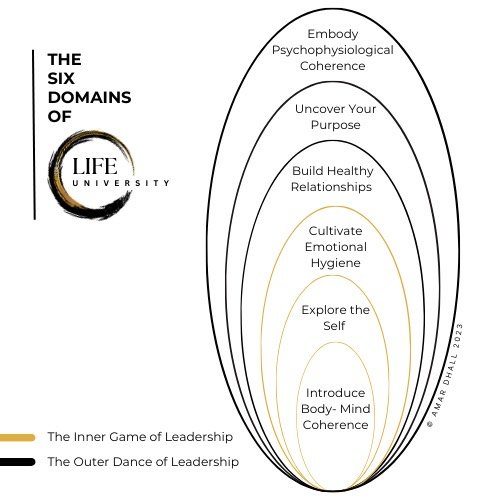How Planning the Life University Led to Uncovering the Biggest Myth-understanding about Body-Mind by Therapists, Healers and Coaches
When I mapped out the process of embodying psychophysiological coherence, I realised that it requires several steps, which led me to perceive and confront one of the biggest and most common misconceptions held by almost every healer, therapist and coach I’ve encountered in recent years.
The myth-conception is the notion that the beginner’s mind (or pure presence) is the critical mindset for a healthy life, as most people are “too heady”, which is another way of saying that over-identification with your thoughts is disembodied and undesirable.
The grain of truth that makes this myth believable is that the big activation of your sympathetic (fight-flight system) and parasympathetic (disassociation/ freeze) nervous systems leads many people to lose or diminish their body awareness. The name of your appropriate sensory system is “interoceptive awareness”. Lowering interoceptive awareness means losing awareness of the information conducted along nerves from your body to your brain. This leads to what lots of people call “being too heady”. The usual remedy prescribed by coaches, therapists and somatic healers is to use breathing techniques/ posture or some kind of practice to “tune in” with your body and get your mind out of the way.
This “too heady” label is nonsense because it fundamentally misunderstands the nature and roles of trauma, top-down regulation, and bottom-up processing in generating psychophysiological coherence. The fact is that psychophysiological coherence requires all of you, which includes your mind. The problem is not that you are “too heady”; it’s that, in all likelihood, deeper trauma shapes your nervous system. The key points are:
There is a reason for your disassociation from your body, which will not change solely by refocusing attention on your body. Focussing your attention on your activated body puts it at loggerheads with your mind, which is trying to quiet it while itself being overactive. This brings to mind a comment by Alan Watts in which he joked (I’m paraphrasing here) it’s no wonder that Buddhism espouses the notion that it takes 10,000 lifetimes to control the mind. Whilst great for membership to the religion, he believed that the mind is too unruly to control and warrants a different approach.
For lasting change, the focus on your body needs to be held along with the deactivation of your nervous system. Most therapists, coaches, and somatic healers don’t know the difference between downregulation and deactivation of the nervous system. I’ll unpack this in another post, but the key difference is that deactivation means completing the activation cycle (which is trauma resolution) whilst downregulation is relaxation, which is temporary and brings no lasting change to your nervous system.
Deactivation is not solely a body-based process; it is a process in which your brain connects with your body which supports the body to heal itself. In other words, it’s not that you’re “too heady”; it’s that you need to metabolise the trigger for your underlying activation. This is somatic trauma work. When that’s resolved, your body-mind will naturally become harmonious because psychophysiological coherence is your natural state.
There is a widespread misunderstanding of the Beginner’s Mind that tends to be overinflated.
There is an oft-cited Zen koan by Shunryu Suzuki:
“In the beginner’s mind, there are many possibilities, but in the expert’s, there are few.”
This usually means something like “when you over-identify with your thoughts and cultivated mastery, you close down possibility and unconsciously presume you know best.” This, in turn, leads many people to believe that they are too in their heads and that they need to stay connected with their bodies.
The two problems with this framing of the koan are:
This is untrue at a biological level: In the true expert’s mind, there are no possibilities because, in flow states, there is a loss of body awareness and integration of all aspects of the self; body, mind, and soul. A deeper issue must be resolved if your expertise doesn’t lead to flow states. Or perhaps it’s the case that more effort is required to become expert, and the koan relates to unconscious competence, which is the training of implicit memory rather than true expertise.
It runs roughshod over the necessity for context, which is run by your brain. Let’s say, for example, you are a mechanic repairing the catalytic converter in a car. As the expert, if you truly embraced the beginner’s mind, you would have no idea what any component did, what tools to use, or why you are even there.
The same applies to regulating your physical and emotional impulses; once triggered, your body wants to complete its impulse. Without your brain to regulate it, you will be driven solely by instinct and impulse. What’s needed is harmony between body and mind, not at all the view that you are “too heady”. Such labels are unhelpful and inaccurate, perpetuating the view that you need fixing. You need to maintain context in all situations; to lose it is part of the horrific natures of Alzheimer’s disease and dementia.
Integrating body, mind, and soul requires reorganisation of the autonomic nervous system, which is mediated by your brain. It’s not that you, or anyone else, is “too heady.” You need your head to resolve trauma and become coherent between body and mind. Supporting psychophysiological coherence is the goal of Life University, which you can learn about here.


